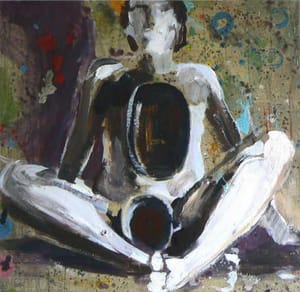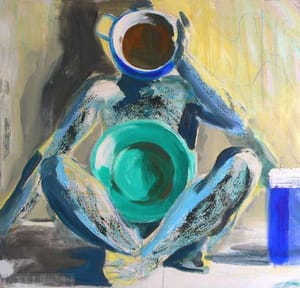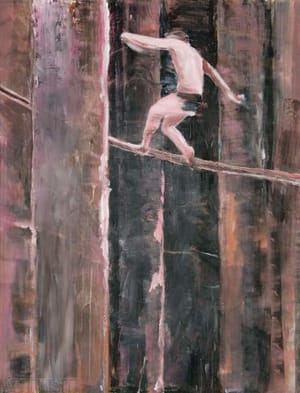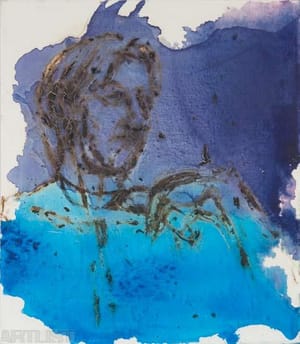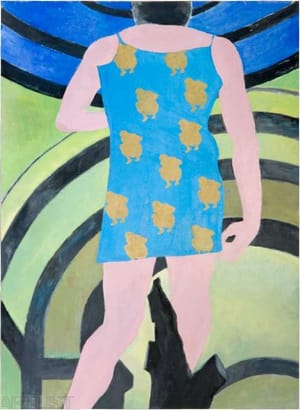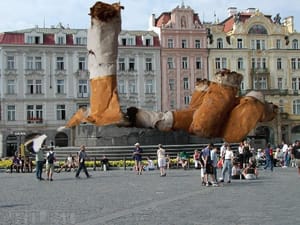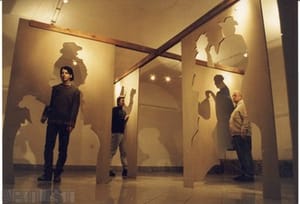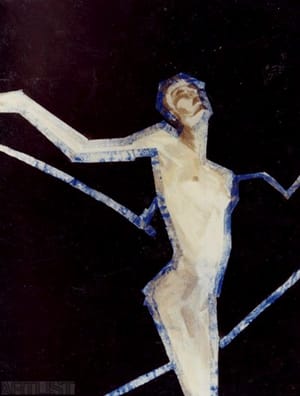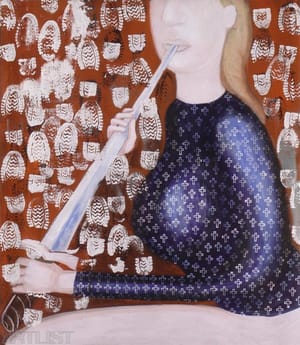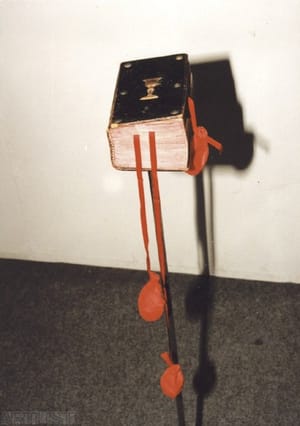- First Name
- Daniel
- Surname
- Balabán
- Born
- 1957
- Birth place
- Šumperk
- Place of work
- Ostrava
- Keywords
- CSU Library
- ↳ Find in the catalogue
About artist
Since the middle of the 1980s Daniel Balabán has been one of the leading artists of the Ostrava art scene and a very important figure in the Czech art world as a whole. He was born on 20 September 1957 in Šumperk, Moravia, but since 1962 has lived in Ostrava. Between 1979 and 1984 he studied at the Professor František Kroudek painting studio at the Academy of Fine Art in Prague, where he became senior lecturer in 2004. From 1993 to 2007 he was head of the painting studio at the Faculty of Fine Art at Ostrava University, and since 2008 has had his own studio at the Institute for Artistic Studies of the same institution.
In his early pictures from the eighties themes relating to the horrors of real socialism and socialist realism (Sower, 1986; Poruba, 1988) are intertwined with sacred themes, which he fully develops later into a brilliant form and which persist in his work basically to the present day. The painting Sower (1986) is a perfect combination of both. The biblical parable of the corn sower as related in St Matthew’s Gospel, combined with the huge shadows of high-rise apartment blocks within a gloomy atmosphere, is an expression of the artist’s internal mood and weariness from the 80s. Balabán became more widely known at the beginning of the 1990s through his canvases featuring classical Christian iconography (Jesus, 1992; St Catherine, 1993). At this time he often reinterpreted the medieval panel portraits by Theodoric of Prague, as can be seen in the work St Catherine (1993). Like Theodoric, using an airy and full colour blotting technique he portrays St Catherine with her typical attribute, a sword, and replaces the decorative pastiglia of the original gothic panel with white prints of the soles of his shoes. Both in his canvases and objects through the whole of the 90s Balabán works almost exclusively with strongly ironised sacred themes, often of Jesus Christ himself (Hymnbook, 1991; Hedgehog in a Cage, 1991; Rattle, 1992).
In his recent paintings religion has been squeezed out or concealed and shifted more in the direction of a kind of spirituality. The human figure meditating on the meaning of life features predominantly, often stylised into the figures of classical works of the giants of global art history, for instance Myron of Eleutherae, Michelangelo, Rodin, and Picasso. For instance, in The Tightrope Walker (2007) the figure on the tightrope is Myron’s Discobolos. However, this figure has lost the ground under its feet for its intended throw, its world as lived. Balabán’s reinterpretations of classical works include David II. (2007) and Portrait (2007), in which we find the famous composition of Michelangelo’s David. Deep spirituality is expressed in the pictures of Buddhist meditation (Buddha, Buddha I, Buddha II, all 2008), in which Balabán avails himself of kitchen crockery to interpret the basic teachings of this school of thought and its invitation to asceticism using the symbol of an empty cake tin, and physical purity using an empty washing up bowl..
As well as classical painting Daniel Balabán also creates digital images (The Old Town Square, 2006) and photography.
- Author of the annotation
- Jakub Král
- Published
- 2012
CV
Studies:
2004 second degree ( associate professor) at the Academy of Fine Arts, Prague
1979-1984 Academy of Fine Arts (prof. František Jiroudek)
Employment:
since 2008 Painting Department at FU OU (also the chairman of the Painting Department)
1993-2007 Painting Department at KVT PF OU
Exhibitions
- Solo exhibitions
-
2011
El a OP, Obrazy z let 2009 a 2010, Galerie Millenium, Praha
2008
Tak co?, Galerie Beseda, Ostrava
2006
Mind the Gap, Dům umění města Brna, Brno
2005
Kdo se bojí smrti, nemůže mít radost ze života, Výstavní síň Sokolská 26, Ostrava
Osudová žena, Galerie Langův dům, Frýdek-Místek
2001
Šebestián a ty další, Galerie Via Art, Praha
2000
Kvanta a prázdna, Galerie výtvarného umění v Ostravě, Ostrava
Výstava obrazů 1988-2000, Českobratrská církev evangelická, Vsetín
1999
Obrazy, Církev bratrská, Ostrava
1998
Vratimov 1996-1998, Galerie Via Art, Praha
Obrazy, Antikvariát a galerie Františka Samoty, Brno
Obrazy, Galerie V Kapli, Bruntál
Výstavní síň Synagoga, Hranice
Betlém, Galerie Langův dům, Frýdek-Místek
Galerie Studio Della, Ostrava
1997
Tenebrace-solarizace, Obrazy z let 1994-1997, Výstavní síň Sokolská 26, Ostrava
Obrazy, Galerie Městské knihovny, Rožnov pod Radhoštěm
Všední nesmrtelnost, Obrazy a fotopráce, Galerie Felixe Jeneweina města Kutné Hory, Kutná Hora
Obrazy 1995-1997, Galerie města Blanska, Blansko
1996
Noc, nebudeš se báti, Obrazy z let 1995-1996, Galerie Langův dům, Frýdek-Místek
1995
Obrazy, Studio Della, Ostrava
Obrazy, Moravská galerie v Brně, Brno
Galerie Fiducia, Ostrava
1993
Obrazy, objekty, Galerie výtvarného umění v Ostravě, Ostrava
Galerie Václava Špály, Praha
Galerie mladých, Brno
Galeria Miejsce, Štětín
1992
Galerie Caesar, Olomouc
Ostravské muzeum, Ostrava
1991
Obrazy 1987-1991, Těšínské divadlo, Český Těšín
Obrazy, Dům umění v Opavě, Opava
Tiller Galerie für moderne Kunst, Sien
1990
Obrazy z let 1988-1990, Galerie Pod Podloubím, Olomouc
Obrazy, Ústřední kulturní dům železničářů, Praha
Evangelický kostel, Ostrava
Divadlo Petra Bezruče, Ostrava
1989
Obrazy z let 1987-1989, Kulturní středisko Blatiny, Praha
Galerie Dílo, Opava
1987
Burza, Praha-Strašnice
1986
Kulturní středisko, Klimkovice
Knihovna, Ostrava-Výškovice
1985
Dům kultury, Orlová
Kino Luna, Ostrava
- Group exhibitions not included in ARTLIST.
-
2011
VI. Nový zlínský salon, Krajská galerie výtvarného umění ve Zlíně, Zlín
…a jiné věci, Galerie Caesar, Olomouc
2010
Přirození po dvaceti letech, Galerie kresby minikino, Ostrava
Smalt Art, Krajina, tělo, záření, Nostický palác, Praha
1984-1995, Česká malba generace 80. let, Wannieck Gallery, Brno
…a nezapomeňte na květiny, Moravská galerie v Brně, Brno
2009
Z nových sbírek Galerie Felixe Jeneweina města Kutné Hory, Galerie Felixe Jeneweina města Kutné Hory, Kutná Hora
2008
Kalendáře pro Jindru Štreita, Galerie Smečky, Praha
Ostrava Art 2008, Ostravské muzeum, Ostrava
2007
Armaro Jilo/Naše srdce, Dům umění města Brna, Brno
2006
Kalendáře pro Jindru Štreita, Galerie výtvarného umění v Ostravě, Ostrava
25 let činnosti Galerie Půda, Galerie Půda, Český Těšín
OVA 95-05, Galerie výtvarného umění v Ostravě, Ostrava
2005
International Biennial of Contemporary Art, Národní galerie v Praze, Praha
Nové přírůstky sbírek Galerie Felixe Jeneweina města Kutné Hory z let 1996-2004, Galerie výtvarného umění v Ostravě, Ostrava
Podzim – památce všech věrných dušiček, Galerie Červený kostel, Hlučín
Daniel Balabán: pokoj Vám, Ivo Sumec: Lepší než život, Galerie Půda, Český Těšín
Galerie 2005, První prezentace galerií příhraničních regionů České republiky a Polska, Výstavní síň Viléma Wünscheho, Havířov
2003
Učitel a žák, Galerie Červený kostel, Hlučín
Ostravská úderka, Galerie města Plzně, Plzeň
Současný akvarel, Galerie U Dobrého pastýře, Brno
Současný akvarel, Galerie Caesar, Olomouc
Současný akvarel, Galerie Měsíc ve dne, České Budějovice
Současný akvarel, Oblastní galerie v Liberci, Liberec
Hochstaplerzy i outsiderzy, Galeria Sektor I, Katowice, PL
Čehu musdienu gleznieciba, Latvijas Mākslas Akademija, Riga, LV
2002
Nové přírůstky sbírek Galerie Felixe Jeneweina města Kutné Hory z let 1996-2001, Galerie Felixe Jeneweina města Kutné Hory, Kutná Hora
Čeští autsajdři/Czescy outsiderzy, Galeria Arsenal, Bialystok, PL
Současný akvarel, Galerie Navrátil, Praha
2001
Súčasná česká serigrafia, Štátná galéria Banská Bystrica, Banská Bystrica, SK
8 z Ostravy, Galerie Caesar, Olomouc
Portrét roku 2000, Galerie Emila Filly, Ústí nad Labem
Výtvarné doteky visegrádské čtyřky, Výtvarné centrum Chagall, Ostrava
Serigrafia dall´Europa centrale/Siebdruck aus Miiteleuropa, Palais Esplanade, Merano, ESP
2000
Současná česká serigrafie, Galerie moderního umění v Hradci Králové, Hradec Králové
Via dolorosa, Výtvarné centrum Chagall, Ostrava
Česká serigrafie, Krajská galerie výtvarného umění ve Zlíně, Zlín
Na volné téma…, ale k věci, Galerie Václava Špály, Praha
Via 2000, Galerie Via Art, Praha
100. výstava Galerie Caesar, Galerie Caesar, Olomouc
Portrét roku 2000, Galerie U Bílého jednorožce, Klatovy
Konec světa, Národní galerie v Praze, Praha
Pocta, Národní technická památka Důl Michal, Ostrava
1999
Česká serigrafie, Dům umění v Opavě, Opava
Česká serigrafie, Staroměstská radnice – Sál architektů, Praha
II. Nový zlínský salon, Krajská galerie výtvarného umění ve Zlíně, Zlín
Akce na podporu kostela sv. Václava, Klub Atlantik, Ostrava
Přirození po X letech, Antikvariát Černý pavouk, Ostrava
Výstava učitelů a žáků PdF OU, Velvyslanectví České republiky v Sarajevu, Sarajevo, BiH
Podlahova OPEN 1999, Katedra výtvarné tvorby PdF OU, Ostrava
1998
Ostrava – umjeni…?, Výstavní síň Mánes, Praha
Ostrava – umjeni…?, Galerie výtvarného umění v Ostravě, Ostrava
Česká serigrafie, Galerie výtvarného umění v Ostravě, Ostrava
Os&tráva, Múzeum Vojtecha Löfflera, Košice, SK
Odpich, Galerie Langův dům, Frýdek-Místek
1997
Novozákonní motivy v českém umění 20. století, Galerie umění Karlovy Vary, Karlovy Vary
Kolmo k ose, Galerie výtvarného umění v Ostravě, Ostrava
Kolmo k ose, Městská nemocnice Ostrava (kožní oddělení), Ostrava
Snížený rozpočet, Výstavní síň Mánes, Praha
Pedagogové katedry výtvarné tvorby Ostravské univerzity - vedoucí ateliéru, Výstavní síň Sokolská 26, Ostrava
1996
Přírůstky 1991-1995, Galerie výtvarného umění v Ostravě, Ostrava
I. Nový zlínský salon, Krajská galerie výtvarného umění ve Zlíně, Zlín
V prostoru 20. století, České umění ze sbírky Galerie hlavního města Prahy, Galerie hlavního města Prahy, Praha
Novozákonní motivy v českém umění 20. století, Galerie moderního umění v Roudnici nad Labem, Roudnice nad Labem
Nedej zahynouti…, Ostrava
Autosalon, Výstaviště Černá louka, Ostrava
1995
Zkušební provoz, Výstavní síň Mánes, Praha
Starý zákon v umění, Kostel U Martina ve zdi, Praha
Starozákonní motivy v českém umění dvacátého století, Galerie moderního umění v Roudnici nad Labem, Roudnice nad Labem
Starozákonní motivy v českém umění dvacátého století, Galerie umění Karlovy Vary, Karlovy Vary
Nevěř nikomu přes třicet, Antikvariát Černý pavouk, Ostrava
Regionální umění ve sbírkách Galerie výtvarného umění v Ostravě, Galerie výtvarného umění v Ostravě, Ostrava
Balabán, Horák, Kalhous, Těšínské divadlo, Český Těšín
1994
Žena sluncem oděná, Diecézní muzeum, Brno
Symbols of three Generations, BWA, Katowice, PL
Symbols of three Generations, Malovaný dům, Třebíč, Praha
Via crucis, Galéria mesta Bratislavy, Bratislava, SK
1993
Jakub a anděl, Výstavní síň Mánes, Praha
Šedá cihla 34/1993, Galerie U Bílého jednorožce, Klatovy
Velké oči, Ostravské muzeum, Ostrava
Via crucis, Strahovský klášter, Praha
1992
Zeichen und Zeugnis, 15 Künstler aus der Tschechoslowakei, Katholische Akademie Wilhelm-Kempf-Haus, Wiesbaden, D
Zeichen und Zeugnis, 15 Künstler aus der Tschechoslowakei, Katholische Akademie Wilhelm-Kempf-Haus, Münster
Výlet do postmoderny, Výstaviště-Pavilon H, Brno
Výlet do postmoderny, Slovenská národná galéria, Bratislava
Nebezpečné známosti, Ostravské muzeum, Ostrava
Dopětatřiceti, Galerie výtvarného umění v Ostravě, Ostrava
Prešpárty, Galerie výtvarného umění v Ostravě, Ostrava
Situace 1970-1989, Galerie výtvarného umění v Ostravě, Ostrava
Galerie hlavního města Prahy, Praha
1991
Zeichen und Zeugnis, 15 Künstler aus der Tschechoslowakei, Galerie an der Finkenstrasse der Deutschen Gesellschaft für christliche Kunst e.V., München, D
Kontrast 90, Ostravské muzeum, Ostrava
Situace 1970-1989, Muzeum Beskyd, Frýdek-Místek
Situace 1970-1989, Galerie Na Půdě, Český Těšín
Situace 1970-1989, Dům kultury, Orlová
Znak a svědectví, Galerie hlavního města Prahy, Praha
Zámek, Kroměříž
Junge Kunst der 80er Jahre aus der Tschechoslowakei, Galerie der Künstler, München, D
Slezský salon, Dům umění v Opavě, Opava
Současné české umění, Taiwan museum of Art, Taiwan
Künstlerische Konfrontationen, Toruň, PL
1990
Skupina Přirození, Divadlo Antonína Dvořáka, Ostrava
Popis jednoho zápasu, Dům umění v Opavě, Opava
Ahoj lidi! II., Podchod Ústředního autobusového nádraží, Ostrava
Rockfest ’90, Ostrava
Neocelové srdce republiky, Výstavní síň Viléma Wünsche, Havířov
Mladí čeští malíři, Budapest, HU
Contemporary Czech Paintings, Walker Hill Art Center, Soul, Korea
1989
Popis jednoho zápasu, Galerie moderního umění v Roudnici nad Labem, Roudnice nad Labem
Popis jednoho zápasu, Galerie výtvarného umění v Chebu, Cheb
Popis jednoho zápasu, Galerie umění Karlovy Vary, Karlovy Vary
Popis jednoho zápasu, Orlická galerie v Rychnově nad Kněžnou, Rychnov nad Kněžnou
Salon nezávislých, Výstaviště Černá louka, Ostrava
Otevřený dialog, Vinohradská tržnice, Praha
Ahoj lidi!, Podchod Ústředního autobusového nádraží, Ostrava
1988
Prešparty ’88, Stretnutie československých výtvarníkov, Múzeum SSR/Múzeum Slovenskej republiky rád, Prešov, SK
Skupina 5+3, Lidový dům, Praha-Vysočany
Rockfest ’88, Ostrava
- Collections
-
Galerie hlavního města Prahy
Galerie Felixe Jeneweina města Kutné Hory
Krajská galerie výtvarného umění v Ostravě
Národní galerie v Praze
Moravská galerie v Brně
Muzeum Beskyd Frýdek-Místek
P. O. S. servis s.r.o.
Wannieck Gallery
Monography
- Monography
Obrazy z let 1987-1989 (kat. výst.), Kulturní středisko Blatiny 1989.
Obrazy z let 1988-1990 (kat. výst.), Galerie Pod Podloubím 1990.
Obrazy (kat. výst.), Ústřední kulturní dům železničářů 1990.
Obrazy z 1987-1991 (kat. výst.), Těšínské divadlo 1991.
Daniel Balabán (kat. výst.), Galerie Caesar 1992.
Daniel Balabán (kat. výst.), Galerie Václava Špály 1993.
Obrazy, objekty (kat. výst.), Galerie výtvarného umění v Ostravě 1993.
Jana Ševčíková, Jiří Ševčík, Heretické obrazy Daniela Balabána, Ateliér VI, č. 5, 4.3.1993, s. 5.
Obrazy (kat. výst.), Moravská galerie v Brně 1995.
Tenebrace-solarizace, Obrazy 1994-1997 (kat. výst.), Výstavní síň Sokolská 26 1997.
Všední nesmrtelnost, Obrazy a fotopráce (kat. výst.), Galerie Felixe Jeneweina města Kutné Hory 1997.
Daniel Balabán (kat. výst.), Výstavní síň Synagoga 1998.
Milan Weber, Nové obrazy Daniela Balabána, Ateliér XI, č. 12, 11.6.1998, s. 6.
Kvanta a prázdna, Obrazy z let 1996-2000 (kat. výst.), Galerie výtvarného umění v Ostravě 2000.
Věra Jirousová, Svatý Šebestián a ty další, Ateliér XIV, č. 20, 11.10.2001, s. 5.
Mind the Gap, Obrazy 2002-2006 (kat. výst.), Dům umění města Brna 2006.
Tak co? (kat. výst.), Galerie Beseda 2008.
- Articles
Slovník českých a slovenských výtvarných umělců 1950-1997, I. A-Č, Výtvarné centrum Chagall, Ostrava
Milan Weber, Ostravská úderka, Ateliér XVI, 3.4.2003, č. 7, s. 1.
Jan Balabán, Na konci moderny?, Ateliér XVIII, 31.3.2005, č. 7, s. 6.
Lenka Lindaurová, Daniel Balabán, Rozhovor, Art & Antiques V, 2006, č. 11, s. 52-65.
František Kowolowski, Daniel Balabán - nové obrazy, Art & Antiques V, 2006, č. 11, s. 93.

